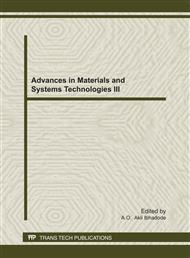p.413
p.421
p.431
p.439
p.449
p.457
p.467
p.475
p.487
Environmental Compliance Monitoring of Selected Physico-Chemical Parameters of Effluent Discharge from Gulf of Guinea Near-Shore / Offshore Facilities
Abstract:
Tests were conducted to analyze selected physico-chemical and microbiological parameters from samples of effluent collected from Gulf of Guinea onshore house-boat facilities and offshore oil production platforms at the discharge point to the recipient environment. Among the parameters determined included: Total chlorine, Biochemical Oxygen demand (BOD), Total Suspended Solids (TSS), Dissolved Oxygen (DO) and Faecal coliform. The discharge loads were evaluated and monitored for eight weeks. Test results indicated that the mean value for total chlorine ranged from 0.12 to 0.60 mg/l for onshore and from 0.26 to 1.4 mg/l for offshore. The BOD5 mean values for the onshore facilities ranged from 15.3 to 52.5 mg/l, for the offshore facilities, it ranged from 27.60 to 117.7 mg/l. The onshore result of the TSS mean values ranged from 53.9 to 62.4 mg/l, the offshore facilities ranged from 77.1 to 242.6 mg/l. The DO mean value results from the onshore facilities ranged from 3.6 to 6.2 mg/l and the result from the offshore facilities ranged from 4.8 to 5.60 mg/l. The faecal coliform for the onshore facilities had a mean value which ranged from 4.0 to 30.1 MPN/100ml, while the offshore facilities had mean value range of 7.4 to 42.0 MPN/100ml. Most of these results are higher than limits specified by the Department of Petroleum Resources (DPR) and an indication that the recipient environment is polluted and poses a great concern. There is therefore utmost need for further treatment before discharge for those parameters that indicated higher ranges than specified for effluent discharge.
Info:
Periodical:
Pages:
449-455
Citation:
Online since:
October 2011
Authors:
Price:
Сopyright:
© 2012 Trans Tech Publications Ltd. All Rights Reserved
Share:
Citation:


